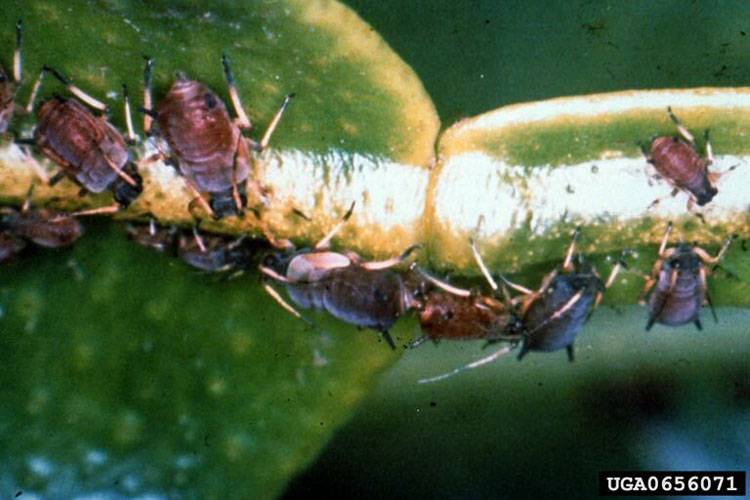Lime
Aphids

Aphids
Toxoptera aurantii, T.citricida

Aphids
Toxoptera aurantii, T.citricida
Citrus Brown Aphid (Toxoptera citricida)
The brown citrus aphid, Toxoptera citricida, is recognized globally as one of the most destructive pests affecting citrus crops. It has a widespread distribution, found across Southeast Asia, sub-Saharan Africa, Australia, New Zealand, the Pacific Islands, South America, the Caribbean, and Florida.
This aphid poses a dual threat to citrus production. Firstly, it directly damages plants by feeding on the sap of young shoots, causing curling, yellowing, and stunted growth. Secondly—and more critically—it is an extremely efficient vector of Citrus Tristeza Virus (CTV), a devastating disease that has caused major losses in citrus orchards worldwide.
Visually, adult wingless forms of the brown citrus aphid are shiny black and relatively large compared to other citrus aphids, while the immature nymphs are dark reddish-brown. However, identifying this species in the field can be challenging due to the presence of other similar-looking aphid species that also infest new citrus growth. Mixed colonies of different aphid species are common, making precise identification more difficult without lab confirmation.
The life cycle of the brown citrus aphid is relatively simple. In most parts of the world, including Florida, it reproduces anholocytically, meaning it does not require a sexual stage. All individuals are female and reproduce via parthenogenesis, giving birth to live young without the need for males or egg-laying. This leads to rapid population growth under favorable conditions. At temperatures of 20°C or above, nymphs reach maturity in just 6 to 8 days. At around 25°C, a single aphid can result in a colony of over 4,400 individuals within three weeks if unchecked by natural enemies. This incredible reproductive capacity makes early detection and control essential.
Citrus Black Aphid (Toxoptera aurantii)
The citrus black aphid, Toxoptera aurantii, is another significant pest that affects citrus and a wide range of other plant species. Unlike the brown citrus aphid, which is primarily a citrus specialist, T. aurantii is polyphagous, meaning it feeds on many plant types, including common crops such as tea, coffee, and ornamentals.
This aphid is well adapted to a broad range of climatic conditions. It thrives in temperatures between 10°C and 30°C, with optimal development occurring around 25°C. Temperatures below 4°C or above 35°C are generally unfavorable for its survival and development. Relative humidity also plays a key role, with the ideal range being between 65% and 70%. Studies have shown that T. aurantii performs best when reared in controlled environments maintaining this level of humidity. Additionally, a photoperiod of 8 hours light and 16 hours dark supports its development.
As with T. citricida, the black citrus aphid can mature from nymph to adult within 6 to 8 days at temperatures of 20°C or more. Its reproductive potential is high—under favorable conditions, one aphid can also lead to a colony of thousands in just a few weeks. Like its brown counterpart, T. aurantii is a known vector of Citrus Tristeza Virus (CTV), which increases its threat level to citrus growers.
Although both species transmit CTV and have similar growth dynamics, their ecological behavior, appearance, and host preferences differ. Effective management of these pests requires proper monitoring, correct species identification, and timely intervention to prevent the spread of disease and minimize crop losses.
Source: Plant Village